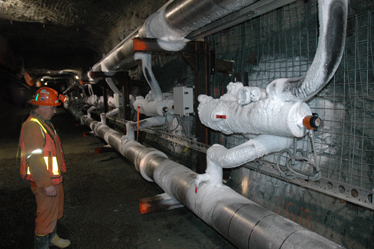The Remediation Project's Freeze Optimization Study
The Project team conducted a Freeze Optimization Study to learn how to manage the arsenic trioxide dust stored underground at Giant Mine.
What did the Project team need to know?
Deciding to freeze the arsenic trioxide in the underground stopes and chambers was just the first step in the remediation process. Many different variables had to be tested, validated and confirmed before the freeze system could be designed and installed. Questions also came out of the Environmental Assessment, and these had to be answered to ensure the public had confidence in the solution. These questions were addressed by conducting a Freeze Optimization Study.
The Giant Mine Remediation Project team began the Freeze Optimization Study in 2011. The study's purpose was to look at things such as:
- the amount of power required to freeze the arsenic
- how fast the area would freeze
- how much water should be used
To look at different ways to create the frozen blocks, the team began preparing to freeze Chamber 10. This is one of the smaller chambers that contains arsenic trioxide dust. The Project team set up temperature sensors around the chamber to closely monitor the freezing progress. Then, thermosyphons and freeze pipes were installed around the chamber, encircling it.
Part of the study included learning whether the freeze system would need to be active or passive. Passive thermosyphons do not use an external power source. Instead, they cool the chamber using the natural movement of pressurized carbon dioxide as it changes temperatures.
The other kind of freezing system the Project looked at is a freeze pipe. Freeze pipes use an external power source to circulate coolant. This is similar to how ice is frozen in a hockey rink. During the study, the pipes were turned on or off as needed. This is known as active freezing.

As the study progressed, the system used both active and passive freezing at different times so the Project team could see the results. Readings collected from the temperature sensors allowed the team to track the freeze in detail. Some areas became as cold as -30°C in the active freezing process.
By October 2013, Chamber 10 was completely contained by a frozen area -5°C (the goal temperature) and colder in some places. This ensured no water could get into, or out of, the chamber.
As well as providing valuable data, the study showed the ground at site cooled faster than expected. As a result, the freeze plan will undergo the following changes:
- the freeze method will be a passive freezing system using thermosyphons as this works as well to freeze the chambers and stopes as an active system
- the chambers and stopes will be cooled to -5°C
- the freeze will use vertical pipes (without horizontal sections)
- multiple stopes will be frozen as one block to improve design efficiency; for example, stopes B212, 213 and 214 will be treated as one chamber
- freezing will be done using a "dry method" (no water will be added to the chambers and stopes)
Learn more: